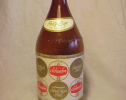jdefoe0424
Ram Guru
Yes, someone could tailor an oil mixture to pass those tests with ease. Now put that same exact mixture in an engine on a dyno and see what happens compared to other oils...And that's what's wrong with the PF "tests", he wants the viewer to believe his "tests" prove one oil is better than another and people love to see tests that prove the product they use is the best. An oil isn't "better" because it trickles down some PVC pipe faster than its competitor, or less burns off in a coffee pot on a griddle.
Here is a newsletter from Blackstone they sent out back in 2017. Inexpensive analysis like Blackstone have some limitations on measuring wear rates but they did a good job comparing the results from thousands of reports they have in their database and couldn't conclude that any one particular oil is the "best". I'll take that over an amateur Youtuber conducting made up tests in his garage.
There's merit to the tests but the results should be taken with a grain of salt.
I agree that, within reason, any oil will protect an engine given a correct change interval, but money(and time) can be saved by using better oil and extending change intervals.
A simple analysis though does not tell the whole story, a very wise man told me that an engine that loses only .01% (pretty sure it was under .05%) of its mass can be useless. That's all the iron the power cylinders have to lose before there's no longer sealing for combustion. It's an incredibly miniscule amount.













